

Compact Muon Solenoid
LHC, CERN
| CMS-HIN-19-013 ; CERN-EP-2020-247 | ||
| In-medium modification of dijets in PbPb collisions at ${\sqrt {\smash [b]{s_{_{\mathrm {NN}}}}}} = $ 5.02 TeV | ||
| CMS Collaboration | ||
| 12 January 2021 | ||
| JHEP 05 (2021) 116 | ||
| Abstract: Modifications to the distribution of charged particles with respect to high transverse momentum (${p_{\mathrm{T}}}$) jets passing through a quark-gluon plasma are explored using the CMS detector. Back-to-back dijets are analyzed in lead-lead and proton-proton collisions at ${\sqrt {\smash [b]{s_{_{\mathrm {NN}}}}}} = $ 5.02 TeV via correlations of charged particles in bins of relative pseudorapidity and angular distance from the leading and subleading jet axes. In comparing the lead-lead and proton-proton collision results, modifications to the charged-particle relative distance distribution and to the momentum distributions around the jet axis are found to depend on the dijet momentum balance ${x_{j}} $, which is the ratio between the subleading and leading jet ${p_{\mathrm{T}}}$. For events with ${x_{j}} \approx $ 1, these modifications are observed for both the leading and subleading jets. However, while subleading jets show significant modifications for events with a larger dijet momentum imbalance, much smaller modifications are found for the leading jets in these events. | ||
| Links: e-print arXiv:2101.04720 [hep-ex] (PDF) ; CDS record ; inSPIRE record ; HepData record ; CADI line (restricted) ; | ||
| Figures & Tables | Summary | Additional Figures | References | CMS Publications |
|---|
| Figures | |
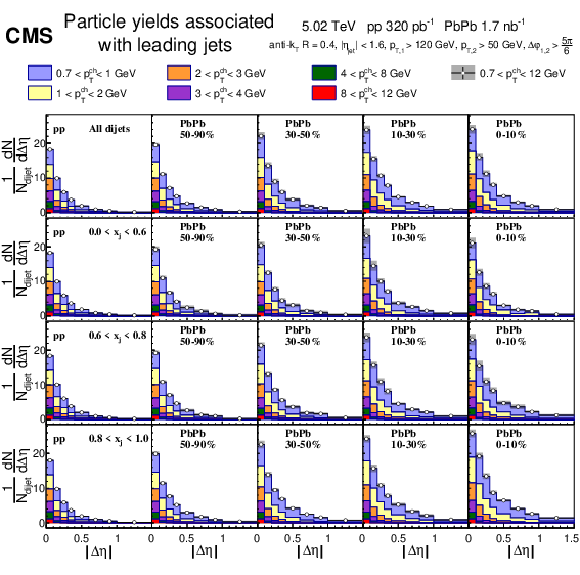
png pdf |
Figure 1:
Distributions of charged-particle yields correlated to leading jets in the region $ {| \Delta \varphi |} < $ 1 as a function of $ {| \Delta \eta |}$ for pp (first column) and PbPb (second to fifth columns) collisions in different centrality bins, shown differentially for all ${{p_{\mathrm {T}}} ^{\mathrm {ch}}}$ bins. The first row shows the charged-particle yields without any selection on ${x_{j}}$, while other rows show the charged-particle yields in different bins of ${x_{j}}$, starting with the most unbalanced 0 $ < {x_{j}} < $ 0.6 (second row) to the most balanced 0.8 $ < {x_{j}} < $ 1.0 (fourth row) dijet events. |
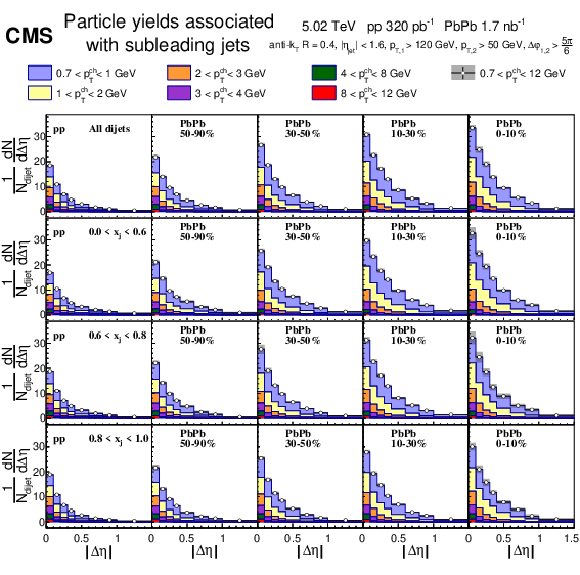
png pdf |
Figure 2:
Distributions of charged-particle yields correlated to subleading jets in the region $ {| \Delta \varphi |} < $ 1 as a function of $ {| \Delta \eta |}$ for pp (first column) and PbPb (second to fifth columns) collisions in different centrality bins, shown differentially for all ${{p_{\mathrm {T}}} ^{\mathrm {ch}}}$ bins. The first row shows the charged-particle yields without any selection on ${x_{j}}$, while other rows show the charged-particle yields in different bins of ${x_{j}}$, starting with the most unbalanced 0 $ < {x_{j}} < $ 0.6 (second row) to the most balanced 0.8 $ < {x_{j}} < $ 1.0 (fourth row) dijet events. |
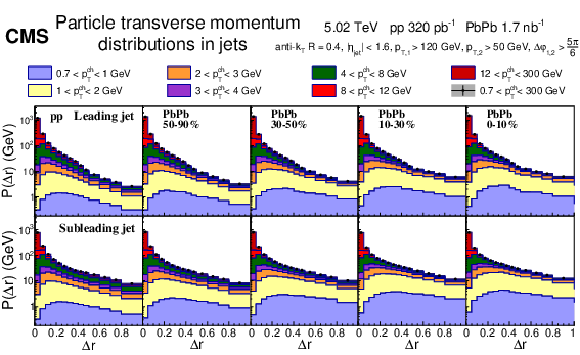
png pdf |
Figure 3:
Jet radial momentum profile $\mathrm {P}(\Delta r)$ for pp (first column) and PbPb (second to fifth columns) collisions in different centrality bins as a function of $\Delta r$, shown differentially in ${{p_{\mathrm {T}}} ^{\mathrm {ch}}}$ for leading (upper row) and subleading (lower row) jets. |
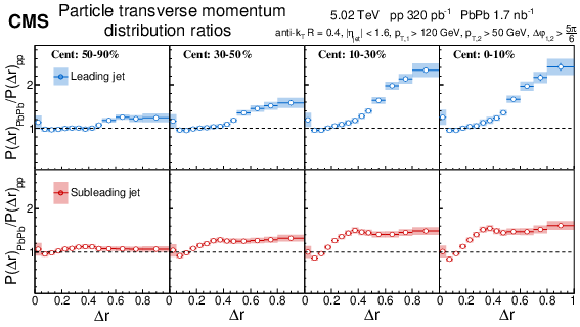
png pdf |
Figure 4:
The PbPb to pp ratio of the jet radial momentum distributions as a function of $\Delta r$, $\mathrm {P} (\Delta r)_{\mathrm {PbPb}}/\mathrm {P} (\Delta r)_{{{\mathrm{p}} {\mathrm{p}}}}$, for different centrality bins for the leading jets (upper row) and subleading jets (lower row). |
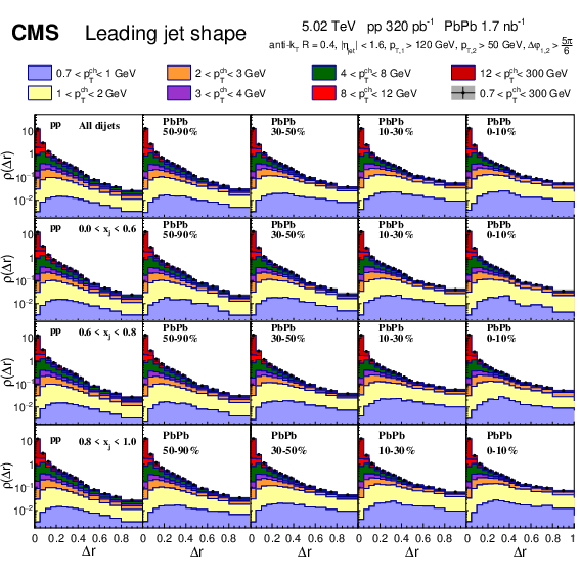
png pdf |
Figure 5:
Leading jet shapes $\rho (\Delta r)$ (normalized to unity over $\Delta r < $ 1) for pp (first column) and PbPb (second to fifth columns) collisions in different centrality bins as a function of $\Delta r$, shown differentially in ${{p_{\mathrm {T}}} ^{\mathrm {ch}}}$ for the inclusive ${x_{j}}$ bin (first row) and in differential bins 0 $ < {x_{j}} < $ 0.6 (second row), 0.6 $ < {x_{j}} < $ 0.8 (third row), and 0.8 $ < {x_{j}} < $ 1.0 (fourth row). |

png pdf |
Figure 6:
The PbPb to pp ratio as a function of $\Delta r$ for leading jet shapes, $ {\rho (\Delta r)_{\mathrm {PbPb}}} / {\rho (\Delta r)_{\mathrm {{{\mathrm{p}} {\mathrm{p}}}}}} $, in different centrality bins for 0 $ < {x_{j}} < $ 0.6 (upper row), 0.6 $ < {x_{j}} < $ 0.8 (middle row) and 0.8 $ < {x_{j}} < $ 1.0 (lower row) dijet selections. The leading jet shape ratio for all dijets, i.e., without any selection on the dijet momentum balance are also shown in each row for comparison. The error bars represent the statistical uncertainties and the shaded areas the systematic uncertainties. |
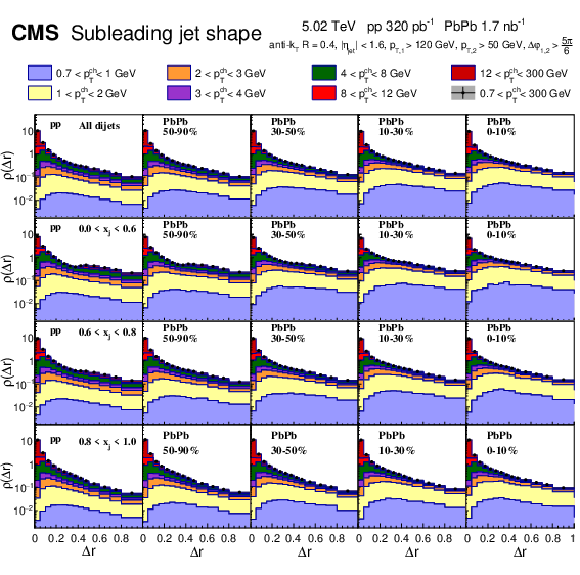
png pdf |
Figure 7:
Subleading jet shapes $\rho (\Delta r)$ (normalized to unity over $\Delta r < $ 1) for pp (first column) and PbPb (second to fifth columns) collisions in different centrality bins as a function of $\Delta r$, shown differentially in ${{p_{\mathrm {T}}} ^{\mathrm {ch}}}$ for the inclusive ${x_{j}}$ bin (first row) and in differential bins 0 $ < {x_{j}} < $ 0.6 (second row), 0.6 $ < {x_{j}} < $ 0.8 (third row), and 0.8 $ < {x_{j}} < $ 1.0 (fourth row). |

png pdf |
Figure 8:
The PbPb to pp ratio as a function of $\Delta r$ for subleading jet shapes, $ {\rho (\Delta r)_{\mathrm {PbPb}}} / {\rho (\Delta r)_{\mathrm {{{\mathrm{p}} {\mathrm{p}}}}}} $, in different centrality bins for 0 $ < {x_{j}} < $ 0.6 (upper row), 0.6 $ < {x_{j}} < $ 0.8 (middle row) and 0.8 $ < {x_{j}} < $ 1.0 (lower row) dijet selections. The subleading jet shape ratio for all dijets, i.e., without any selection on the dijet momentum balance are also shown in each row for comparison. The error bars represent the statistical uncertainties and the shaded areas the systematic uncertainties. |
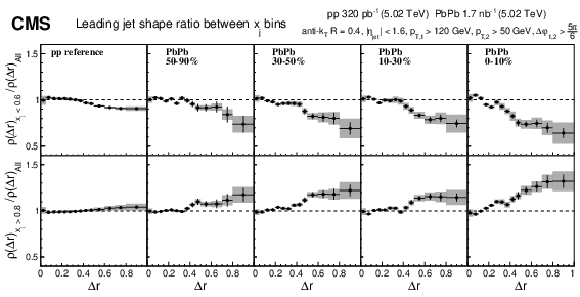
png pdf |
Figure 9:
Ratio of momentum-unbalanced (0.0 $ < {x_{j}} < $ 0.6, upper row) and balanced (0.8 $ < {x_{j}} < $ 1.0, lower row) jet shapes to ${x_{j}}$ integrated jet shapes for leading jets in pp collisions and different PbPb centrality bins as a function of $\Delta r$. The error bars represent the statistical uncertainties and the shaded areas the systematic uncertainties. |
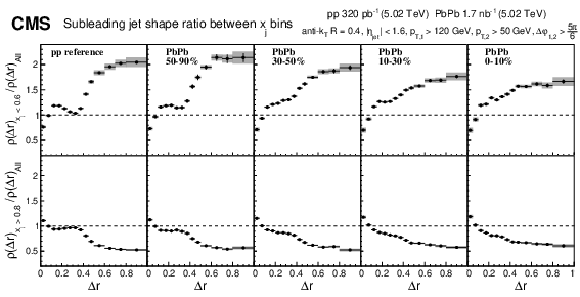
png pdf |
Figure 10:
Ratio of momentum-unbalanced (0.0 $ < {x_{j}} < $ 0.6, upper row) and balanced (0.8 $ < {x_{j}} < $ 1.0, lower row) jet shapes to ${x_{j}}$ integrated jet shapes for subleading jets in pp collisions and different PbPb centrality bins as a function of $\Delta r$. The error bars represent the statistical uncertainties and the shaded areas the systematic uncertainties. |
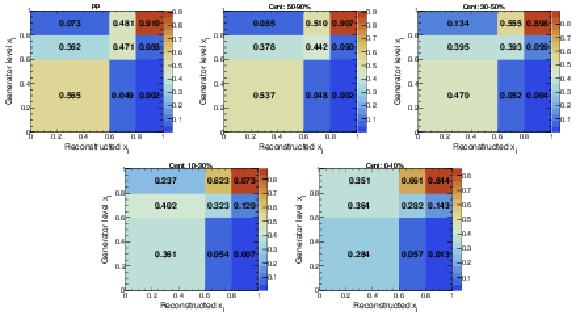
png pdf |
Figure 11:
Generator-level vs. reconstructed ${x_{j}}$ values in the analysis ${x_{j}}$ bins. The plots show the probability to find a generator level ${x_{j}}$ for a given reconstructed ${x_{j}}$. The PYTHIA 8 simulation is shown in the upper-left plot while the most central PYTHIA+HYDJET is shown in the lower-right plot. |

png pdf |
Figure 11-a:
Generator-level vs. reconstructed ${x_{j}}$ values in the analysis ${x_{j}}$ bins. The plots show the probability to find a generator level ${x_{j}}$ for a given reconstructed ${x_{j}}$. The PYTHIA 8 simulation is shown. |
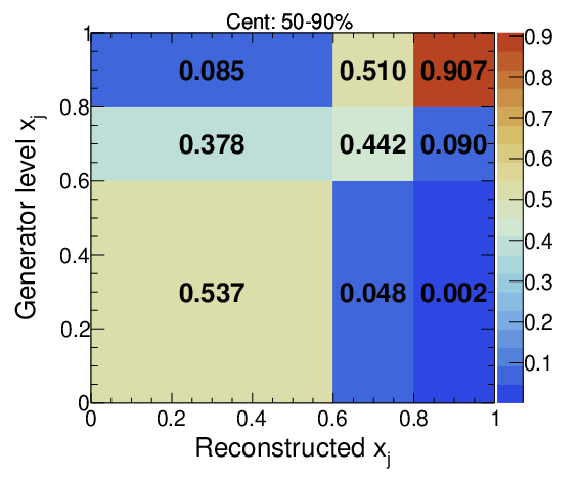
png pdf |
Figure 11-b:
Generator-level vs. reconstructed ${x_{j}}$ values in the analysis ${x_{j}}$ bins. The plots show the probability to find a generator level ${x_{j}}$ for a given reconstructed ${x_{j}}$. The PYTHIA+HYDJET simulation is shown in the 50-90% centrality bin. |

png pdf |
Figure 11-c:
Generator-level vs. reconstructed ${x_{j}}$ values in the analysis ${x_{j}}$ bins. The plots show the probability to find a generator level ${x_{j}}$ for a given reconstructed ${x_{j}}$. The PYTHIA+HYDJET simulation is shown in the 30-50% centrality bin. |

png pdf |
Figure 11-d:
Generator-level vs. reconstructed ${x_{j}}$ values in the analysis ${x_{j}}$ bins. The plots show the probability to find a generator level ${x_{j}}$ for a given reconstructed ${x_{j}}$. The PYTHIA+HYDJET simulation is shown in the 10-30% centrality bin. |
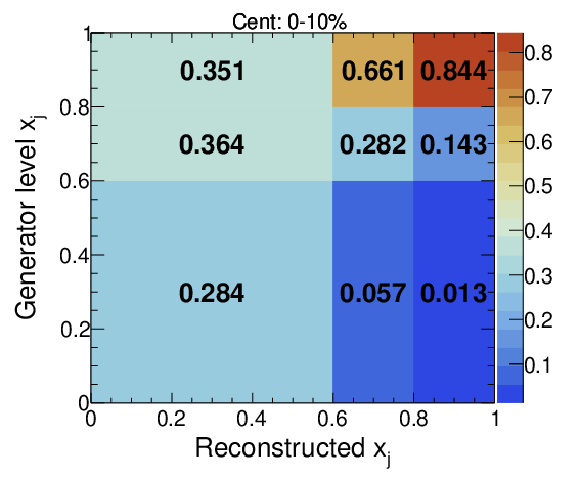
png pdf |
Figure 11-e:
Generator-level vs. reconstructed ${x_{j}}$ values in the analysis ${x_{j}}$ bins. The plots show the probability to find a generator level ${x_{j}}$ for a given reconstructed ${x_{j}}$. The PYTHIA+HYDJET simulation is shown in the 0-10% centrality bin. |
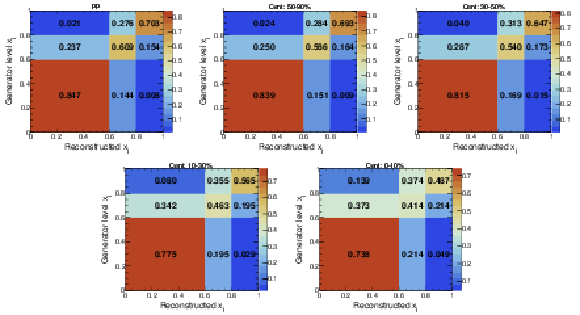
png pdf |
Figure 12:
Generator-level vs. reconstructed ${x_{j}}$ values in the analysis ${x_{j}}$ bins. The plots show the probability to find a reconstructed ${x_{j}}$ for a given generator level ${x_{j}}$. The PYTHIA 8 simulation is shown in the upper-left plot while the most central PYTHIA+HYDJET is shown in the lower-right plot. |

png pdf |
Figure 12-a:
Generator-level vs. reconstructed ${x_{j}}$ values in the analysis ${x_{j}}$ bins. The plots show the probability to find a reconstructed ${x_{j}}$ for a given generator level ${x_{j}}$. The PYTHIA 8 simulation is shown. |

png pdf |
Figure 12-b:
Generator-level vs. reconstructed ${x_{j}}$ values in the analysis ${x_{j}}$ bins. The plots show the probability to find a reconstructed ${x_{j}}$ for a given generator level ${x_{j}}$. The PYTHIA+HYDJET simulation is shown in the 50-90% centrality bin. |
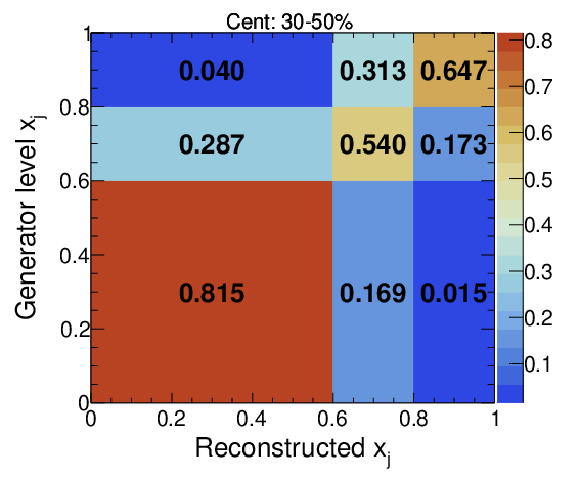
png pdf |
Figure 12-c:
Generator-level vs. reconstructed ${x_{j}}$ values in the analysis ${x_{j}}$ bins. The plots show the probability to find a reconstructed ${x_{j}}$ for a given generator level ${x_{j}}$. The PYTHIA+HYDJET simulation is shown in the 30-50% centrality bin. |

png pdf |
Figure 12-d:
Generator-level vs. reconstructed ${x_{j}}$ values in the analysis ${x_{j}}$ bins. The plots show the probability to find a reconstructed ${x_{j}}$ for a given generator level ${x_{j}}$. The PYTHIA+HYDJET simulation is shown in the 10-30% centrality bin. |
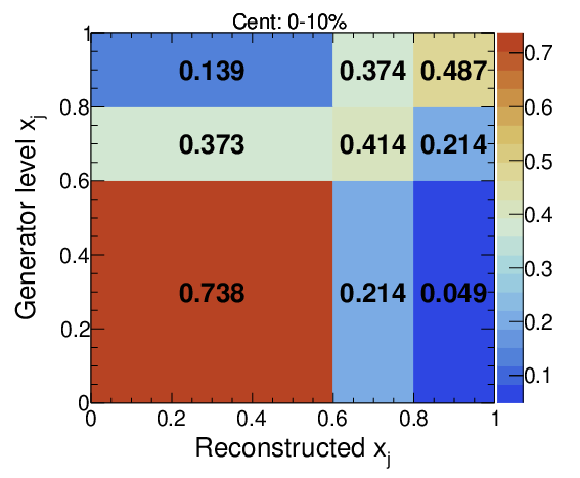
png pdf |
Figure 12-e:
Generator-level vs. reconstructed ${x_{j}}$ values in the analysis ${x_{j}}$ bins. The plots show the probability to find a reconstructed ${x_{j}}$ for a given generator level ${x_{j}}$. The PYTHIA+HYDJET simulation is shown in the 0-10% centrality bin. |
| Tables | |

png pdf |
Table 1:
The total number of events for pp and for different PbPb centrality bins are shown in the top row. The other rows show the percentage of all events that falls within a given ${x_{j}}$ bin. |

png pdf |
Table 2:
Systematic uncertainties for the leading jet shape components, integrated over ${x_{j}}$, and $\Delta r$, and shown for pp and centrality-binned PbPb collisions. The ranges correspond to the ${p_{\mathrm {T}}}$ dependence of the uncertainty. If some ${p_{\mathrm {T}}}$ bins have an uncertainty smaller than 0.5%, the range is presented with a "$ < $" symbol and the upper bound. |

png pdf |
Table 3:
Systematic uncertainties for the subleading jet shape components, integrated over ${x_{j}}$, and $\Delta r$, and shown for pp and centrality-binned PbPb collisions. The ranges correspond to the ${p_{\mathrm {T}}}$ dependence of the uncertainty. If some ${p_{\mathrm {T}}}$ bins have an uncertainty smaller than 0.5%, the range is presented with a "$ < $" symbol and the upper bound. |
| Summary |
|
The CMS experiment has measured charged-particle yields and jet shapes in events containing back-to-back dijet pairs around the jet axes using data from proton-proton (pp) and lead-lead (PbPb) collisions at ${\sqrt {\smash [b]{s_{_{\mathrm {NN}}}}}} = $ 5.02 TeV collected in 2017 and 2018. When comparing the charged-particle yields around the jet axes, an excess of low transverse momentum (${p_{\mathrm{T}}}$) particles is observed in PbPb with respect to pp collisions. This excess is larger for subleading jets compared to leading jets. The excess is also found to have a different dijet momentum balance ${x_{j}} = {p_{\mathrm{T}}^{\text{subleading}}} / {p_{\mathrm{T}}^{\text{leading}}}$ dependence for the leading and subleading jets. A possible cause for ${x_{j}} $ imbalance is that the leading jet is produced near the surface of the quark-gluon plasma while the subleading jet needs to traverse a longer distance through the plasma. The leading jets show the strongest modifications in balanced events (${x_{j}} \approx $ 1), while subleading jets experience the most pronounced modifications in events with a large jet momentum imbalance. A possible explanation is that in balanced events both jets lose a comparable amount of energy, while in events with a momentum imbalance the leading jet loses significantly less energy. Furthermore, jet quenching could lead to the reversal of the apparent leading/subleading ordering. For the jet shapes, which are normalized distributions of charged-particle transverse momentum as a function of the distance from the jet axis, a redistribution of energy is observed from small angles with respect to the jet axis to larger angles when comparing PbPb and pp events. The difference between the PbPb and pp results is larger for the leading jets compared to the subleading jets, which can be explained by the subleading jet distribution in pp collisions being significantly wider than that for leading jets. When studying the unbalanced ${x_{j}} $ selection for the subleading jets in pp collisions, a fragmentation pattern consistent with the presence of a third jet is observed. Such a pattern is not observed in balanced pp events or in the PbPb sample. As a result, the enhancement of the PbPb to pp ratio for unbalanced events peaks around $\Delta r = 0.4$ and becomes smaller at larger $\Delta r$. When comparing the jet shapes corresponding to different dijet momentum balance conditions, the distributions for leading jets are found to be the widest for events with balanced jet momenta. For subleading jets, the situation is the opposite, and the widest distributions are found from events having a significant momentum imbalance. These observations are consistent with the interpretation of the charged-particle yield measurements, namely that the average path length inside the medium for leading jets is larger for momentum balanced events, while for subleading jets it is larger in unbalanced events. By studying the charged-particle yields correlated to jets and jet shapes for the first time as a function of dijet momentum balance, this study provides new constraints to the theoretical models and provides a unique way to explore the transition between the domains of weakly and strongly interacting QCD matter. |
| Additional Figures | |
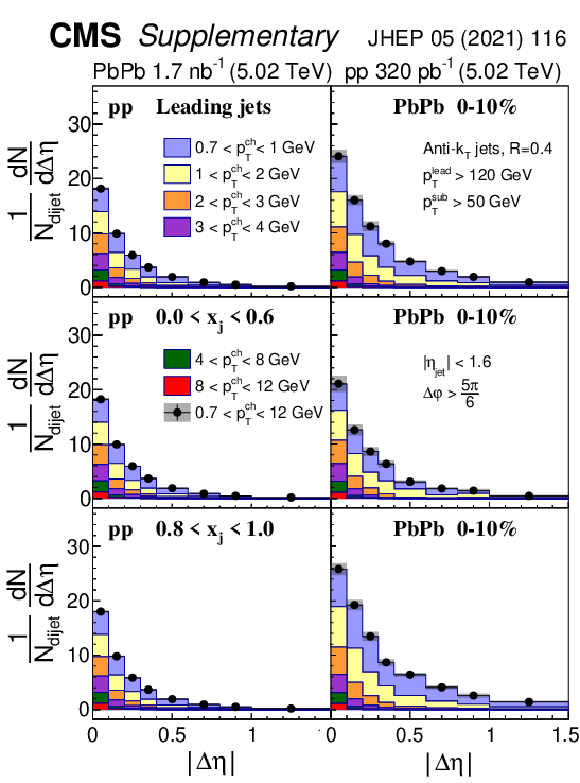
png pdf |
Additional Figure 1:
Distributions of charged particle yields correlated to leading jets as a function of $|\Delta \eta |$ for pp (first column) and 0-10 % central PbPb collisions (second column), shown differentially for all charged particle transverse momentum $(p_{\rm T}^{\rm ch})$ bins. The first row shows the charged particle yields without any selection on $x_{j} = {{p_{\mathrm {T}}} {}^{\mathrm {subleading}}}/{{p_{\mathrm {T}}} {}^{\mathrm {leading}}}$, while other rows show the charged particle yields in different bins of $x_{j}$, starting with the most unbalanced 0 $ < x_{j} < $ 0.6 (second row) to the most balanced 0.8 $ < x_{j} < $ 1.0 (third row) dijet events. |

png pdf |
Additional Figure 2:
Distributions of charged particle yields correlated to subleading jets as a function of $|\Delta \eta |$ for pp (first column) and 0-10 % central PbPb collisions (second column), shown differentially for all charged particle transverse momentum $(p_{\rm T}^{\rm ch})$ bins. The first row shows the charged particle yields without any selection on $x_{j} = {{p_{\mathrm {T}}} {}^{\mathrm {subleading}}}/{{p_{\mathrm {T}}} {}^{\mathrm {leading}}}$, while other rows show the charged particle yields in different bins of $x_{j}$, starting with the most unbalanced 0 $ < x_{j} < $ 0.6 (second row) to the most balanced 0.8 $ < x_{j} < $ 1.0 (third row) dijet events. |
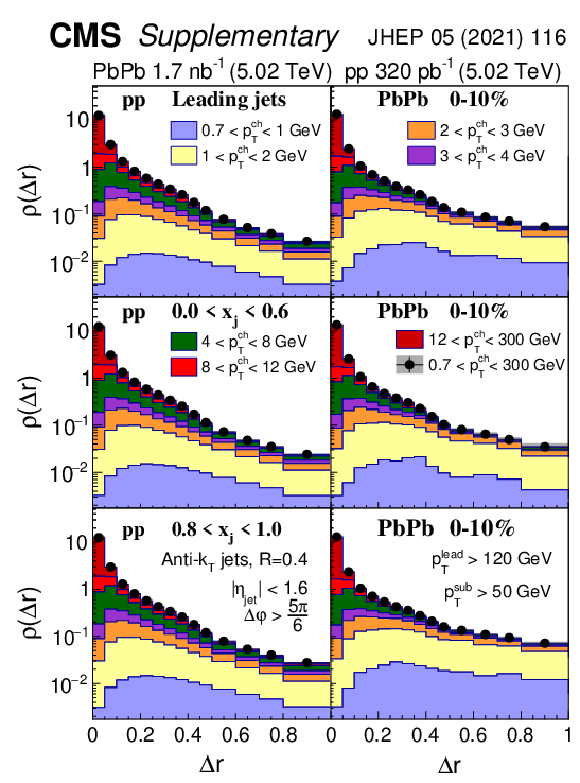
png pdf |
Additional Figure 3:
Leading jet shapes $\rho (\Delta r)$ (normalized to unity over $\Delta r < $ 1) for pp (first column) and 0-10 % central PbPb collisions (second column), shown differentially in charged particle transverse momentum $(p_{\rm T}^{\rm ch})$ for inclusive $x_{j} = {{p_{\mathrm {T}}} {}^{\mathrm {subleading}}}/{{p_{\mathrm {T}}} {}^{\mathrm {leading}}}$ bin (first row) and in $x_{j}$ bins 0 $ < x_{j} < $ 0.6 (second row) and 0.8 $ < x_{j} < $ 1.0 (third row). |

png pdf |
Additional Figure 4:
Subleading jet shapes $\rho (\Delta r)$ (normalized to unity over $\Delta r < $ 1) for pp (first column) and 0-10 % central PbPb collisions (second column), shown differentially in charged particle transverse momentum $(p_{\rm T}^{\rm ch})$ for inclusive $x_{j} = {{p_{\mathrm {T}}} {}^{\mathrm {subleading}}}/{{p_{\mathrm {T}}} {}^{\mathrm {leading}}}$ bin (first row) and in $x_{j}$ bins 0 $ < x_{j} < $ 0.6 (second row) and 0.8 $ < x_{j} < $ 1.0 (third row). |

png pdf |
Additional Figure 5:
PbPb to pp ratio for leading jet shapes $\rho (\Delta r)_{\rm PbPb} / \rho (\Delta r)_{\rm pp}$ for events in the 0-10 % centrality class. The gray points show $x_{j} = {{p_{\mathrm {T}}} {}^{\mathrm {subleading}}}/{{p_{\mathrm {T}}} {}^{\mathrm {leading}}}$ integrated ratio, while the red points are the ratio in 0 $ < x_{j} < $ 0.6 bin and blue points in 0.8 $ < x_{j} < $ 1.0 bin. Error bars are statistical uncertainties while the shaded areas show systematic uncertainties. |
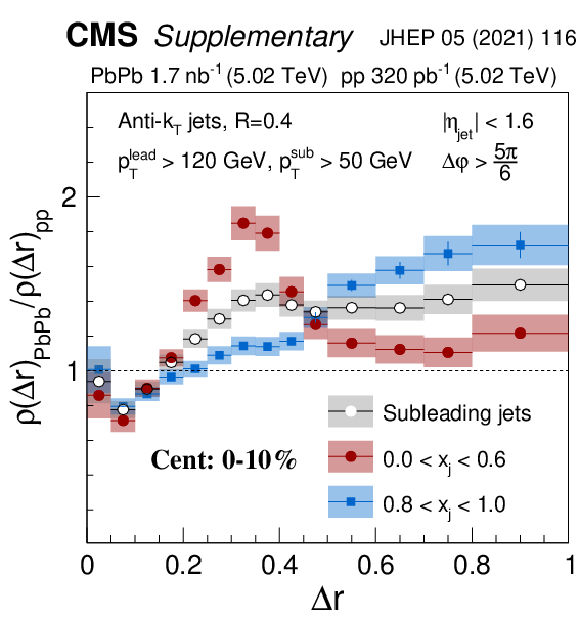
png pdf |
Additional Figure 6:
PbPb to pp ratio for subleading jet shapes $\rho (\Delta r)_{\rm PbPb} / \rho (\Delta r)_{\rm pp}$ for events in the 0-10 % centrality class. The gray points show $x_{j} = {{p_{\mathrm {T}}} {}^{\mathrm {subleading}}}/{{p_{\mathrm {T}}} {}^{\mathrm {leading}}}$ integrated ratio, while the red points are the ratio in 0 $ < x_{j} < $ 0.6 bin and blue points in 0.8 $ < x_{j} < $ 1.0 bin. Error bars are statistical uncertainties while the shaded areas show systematic uncertainties. |
| References | ||||
| 1 | W. Busza, K. Rajagopal, and W. van der Schee | Heavy ion collisions: the big picture, and the big questions | Ann. Rev. Nucl. Part. Sci. 68 (2018) 339 | 1802.04801 |
| 2 | J. D. Bjorken | Energy loss of energetic partons in QGP: possible extinction of high $ {p_{\mathrm{T}}} $ jets in hadron-hadron collisions | FERMILAB-PUB-82-059-THY | |
| 3 | STAR Collaboration | Direct observation of dijets in central Au+Au collisions at $ {\sqrt {\smash [b]{s_{_{\mathrm {NN}}}}}} = $ 200 GeV | PRL 97 (2006) 162301 | nucl-ex/0604018 |
| 4 | PHENIX Collaboration | Transverse momentum and centrality dependence of dihadron correlations in Au+Au collisions at $ {\sqrt {\smash [b]{s_{_{\mathrm {NN}}}}}} = $ 200 GeV: Jet-quenching and the response of partonic matter | PRC 77 (2008) 011901 | 0705.3238 |
| 5 | ATLAS Collaboration | Observation of a centrality-dependent dijet asymmetry in lead-lead collisions at $ {\sqrt {\smash [b]{s_{_{\mathrm {NN}}}}}} = $ 2.76 TeV with the ATLAS detector at the LHC | PRL 105 (2010) 252303 | 1011.6182 |
| 6 | CMS Collaboration | Observation and studies of jet quenching in PbPb collisions at $ {\sqrt {\smash [b]{s_{_{\mathrm {NN}}}}}} = $ 2.76 TeV | PRC 84 (2011) 024906 | CMS-HIN-10-004 1102.1957 |
| 7 | CMS Collaboration | Jet momentum dependence of jet quenching in PbPb collisions at $ {\sqrt {\smash [b]{s_{_{\mathrm {NN}}}}}} = $ 2.76 TeV | PLB 712 (2012) 176 | CMS-HIN-11-013 1202.5022 |
| 8 | ALICE Collaboration | Measurement of jet suppression in central Pb--Pb collisions at $ {\sqrt {\smash [b]{s_{_{\mathrm {NN}}}}}} = $ 2.76 TeV | PLB 746 (2015) 1 | 1502.01689 |
| 9 | BRAHMS Collaboration | Quark gluon plasma and color glass condensate at RHIC? The Perspective from the BRAHMS experiment | NP A 757 (2005) 1 | nucl-ex/0410020 |
| 10 | PHOBOS Collaboration | The PHOBOS perspective on discoveries at RHIC | NP A 757 (2005) 28 | nucl-ex/0410022 |
| 11 | STAR Collaboration | Experimental and theoretical challenges in the search for the quark gluon plasma: The STAR Collaboration's critical assessment of the evidence from RHIC collisions | NP A 757 (2005) 102 | nucl-ex/0501009 |
| 12 | PHENIX Collaboration | Formation of dense partonic matter in relativistic nucleus-nucleus collisions at RHIC: Experimental evaluation by the PHENIX collaboration | NP A 757 (2005) 184 | nucl-ex/0410003 |
| 13 | CMS Collaboration | Measurement of jet fragmentation in PbPb and $ pp $ collisions at $ {\sqrt {\smash [b]{s_{_{\mathrm {NN}}}}}} = $ 2.76 TeV | PRC 90 (2014) 024908 | CMS-HIN-12-013 1406.0932 |
| 14 | ATLAS Collaboration | Measurement of inclusive jet charged-particle fragmentation functions in Pb+Pb collisions at $ {\sqrt {\smash [b]{s_{_{\mathrm {NN}}}}}} = $ 2.76 TeV with the ATLAS detector | PLB 739 (2014) 320 | 1406.2979 |
| 15 | CMS Collaboration | Modification of jet shapes in PbPb collisions at $ {\sqrt {\smash [b]{s_{_{\mathrm {NN}}}}}} = $ 2.76 TeV | PLB 730 (2014) 243 | CMS-HIN-12-002 1310.0878 |
| 16 | CMS Collaboration | Measurement of transverse momentum relative to dijet systems in PbPb and $ pp $ collisions at $ {\sqrt {\smash [b]{s_{_{\mathrm {NN}}}}}} = $ 2.76 TeV | JHEP 01 (2016) 6 | CMS-HIN-14-010 1509.09029 |
| 17 | CMS Collaboration | Correlations between jets and charged particles in PbPb and $ pp $ collisions at $ {\sqrt {\smash [b]{s_{_{\mathrm {NN}}}}}} = $ 2.76 TeV | JHEP 02 (2016) 156 | CMS-HIN-14-016 1601.00079 |
| 18 | CMS Collaboration | Decomposing transverse momentum balance contributions for quenched jets in PbPb collisions at $ {\sqrt {\smash [b]{s_{_{\mathrm {NN}}}}}} = $ 2.76 TeV | JHEP 11 (2016) 055 | CMS-HIN-15-011 1609.02466 |
| 19 | CMS Collaboration | Jet properties in PbPb and $ pp $ collisions at $ {\sqrt {\smash [b]{s_{_{\mathrm {NN}}}}}} = $ 5.02 TeV | JHEP 05 (2018) 006 | CMS-HIN-16-020 1803.00042 |
| 20 | L. Apolinario, N. Armesto, and L. Cunqueiro | An analysis of the influence of background subtraction and quenching on jet observables in heavy-ion collisions | JHEP 02 (2013) 022 | 1211.1161 |
| 21 | A. Ayala, I. Dominguez, J. Jalilian-Marian, and M. E. Tejeda-Yeomans | Jet asymmetry and momentum imbalance from $ 2 \to 2 $ and $ 2 \to 3 $ partonic processes in relativistic heavy-ion collisions | PRC 92 (2015) 044902 | 1503.06889 |
| 22 | J.-P. Blaizot, Y. Mehtar-Tani, and M. A. C. Torres | Angular structure of the in-medium QCD cascade | PRL 114 (2015) 222002 | 1407.0326 |
| 23 | M. A. Escobedo and E. Iancu | Event-by-event fluctuations in the medium-induced jet evolution | JHEP 05 (2016) 008 | 1601.03629 |
| 24 | J. Casalderrey-Solana et al. | Angular structure of jet quenching within a hybrid strong/weak coupling model | JHEP 03 (2017) 135 | 1609.05842 |
| 25 | Y. Tachibana, N.-B. Chang, and G.-Y. Qin | Full jet in quark-gluon plasma with hydrodynamic medium response | PRC 95 (2017) 044909 | 1701.07951 |
| 26 | CMS Collaboration | Performance of the CMS level-1 trigger in proton-proton collisions at $ \sqrt{s} = $ 13 TeV | JINST 15 (2020) P10017 | CMS-TRG-17-001 2006.10165 |
| 27 | CMS Collaboration | The CMS trigger system | JINST 12 (2017) P01020 | CMS-TRG-12-001 1609.02366 |
| 28 | CMS Collaboration | The CMS experiment at the CERN LHC | JINST 3 (2008) S08004 | CMS-00-001 |
| 29 | M. Cacciari, G. P. Salam, and G. Soyez | The anti-$ {k_{\mathrm{T}}} $ jet clustering algorithm | JHEP 04 (2008) 063 | 0802.1189 |
| 30 | O. Kodolova, I. Vardanyan, A. Nikitenko, and A. Oulianov | The performance of the jet identification and reconstruction in heavy ions collisions with CMS detector | EPJC 50 (2007) 117 | |
| 31 | CMS Collaboration | Dependence on pseudorapidity and centrality of charged hadron production in PbPb collisions at a nucleon-nucleon centre-of-mass energy of 2.76 TeV | JHEP 08 (2011) 141 | CMS-HIN-10-001 1107.4800 |
| 32 | T. Sjostrand et al. | An introduction to PYTHIA 8.2 | CPC 191 (2015) 159 | 1410.3012 |
| 33 | CMS Collaboration | Extraction and validation of a new set of CMS PYTHIA 8 tunes from underlying-event measurements | EPJC 80 (2020) 4 | CMS-GEN-17-001 1903.12179 |
| 34 | NNPDF Collaboration | Parton distributions from high-precision collider data | EPJC 77 (2017) 663 | 1706.00428 |
| 35 | GEANT4 Collaboration | GEANT4 --- a simulation toolkit | NIMA 506 (2003) 250 | |
| 36 | I. P. Lokhtin et al. | Heavy ion event generator HYDJET++ (HYDrodynamics plus JETs) | CPC 180 (2009) 779 | 0809.2708 |
| 37 | M. Cacciari, G. P. Salam, and G. Soyez | FastJet user manual | EPJC 72 (2012) 1896 | 1111.6097 |
| 38 | CMS Collaboration | Particle-flow reconstruction and global event description with the CMS detector | JINST 12 (2017) P10003 | CMS-PRF-14-001 1706.04965 |
| 39 | D. Bertolini, T. Chan, and J. Thaler | Jet observables without jet algorithms | JHEP 04 (2014) 013 | 1310.7584 |
| 40 | A. J. Larkoski, D. Neill, and J. Thaler | Jet shapes with the broadening axis | JHEP 04 (2014) 017 | 1401.2158 |
| 41 | P. Berta, M. Spousta, D. W. Miller, and R. Leitner | Particle-level pileup subtraction for jets and jet shapes | JHEP 06 (2014) 092 | 1403.3108 |
| 42 | CMS Collaboration | Description and performance of track and primary-vertex reconstruction with the CMS tracker | JINST 9 (2014) P10009 | CMS-TRK-11-001 1405.6569 |
| 43 | CMS Collaboration | Charged-particle nuclear modification factors in PbPb and pPb collisions at $ {\sqrt {\smash [b]{s_{_{\mathrm {NN}}}}}} = $ 5.02 TeV | JHEP 04 (2017) 039 | CMS-HIN-15-015 1611.01664 |
| 44 | CMS Collaboration | Measurement of jet fragmentation into charged particles in $ pp $ and PbPb collisions at $ {\sqrt {\smash [b]{s_{_{\mathrm {NN}}}}}} = $ 2.76 TeV | JHEP 10 (2012) 087 | CMS-HIN-11-004 1205.5872 |
| 45 | CMS Collaboration | Jet energy scale and resolution in the CMS experiment in $ pp $ collisions at 8 TeV | JINST 12 (2017) P02014 | CMS-JME-13-004 1607.03663 |
| 46 | T. Renk | Theoretical assessment of jet-hadron correlations | PRC 87 (2013) 024905 | 1210.1330 |

|
Compact Muon Solenoid LHC, CERN |

|

|

|

|

|

|